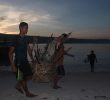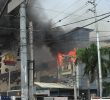The International Crisis Group, considered as the best expert on terrorism in Southeast Asia, has released a briefing on Jemaah Islamiyah, the Indonesian terror network that has found its way to the Philippines, particularly Mindanao. The report essentially tells us what the JI has been up to, what is its present structure and whether it remains capable of more attacks in the region.
The report’s section on JI in Mindanao points out that, contrary to what the Philippine military has been saying, the “mainstream JI members” in Mindanao –about nine of them, including Dulmatin and Umar Patek –“have little to do with the ‘fugitives’ working with the Abu Sayyaf Group.”
It also says a dozen or more other “structural” JI members are under the protection of the Moro Islamic Liberation, although these members are said to be inactive and are “under strict orders not to engage in any violence and are considered integrated with MILF forces.”
Below is the Crisis Groups’s full report on JI:
Update Briefing
Asia Briefing N�63
Jakarta/Brussels, 3 May 2007
Indonesia: Jemaah Islamiyah�s Current Status
I. OVERVIEW
In late March 2007, arrests by Densus 88, the police counter-terror unit, netted seven detainees in Central and East Java (an eighth was killed); a huge cache of explosives and weaponry; and documents that seemed to suggest a new military structure for Jemaah Islamiyah (JI), the region�s largest jihadist organisation. The arrests followed directly from information obtained from operations in Poso, Central Sulawesi, in late January.
Wildly differing assessments of JI�s state in the aftermath of the March raids suggest a more systematic stock-taking is in order. What remains of the organisation today? What are its aims, and funding sources? Where are its strongholds? Who are its leaders? What is its relationship with other jihadist organisations at home and abroad? Crisis Group believes JI retains a solid core that probably totals more than 900 members across Indonesia. It likely is not growing but it retains deep roots and a long-term vision of establishing an Islamic state.
While the organisation of its military wing may have changed � but the materials found in March raise more questions than they answer � JI�s strength remains rooted in a territorial command structure, with a five- or six-person religious study circle as the basic building block. Its administrative hierarchy has been largely reduced to what was once Mantiqi II, the division that covers Indonesia, making the head of Mantiqi II (Nuaim alias Abu Irsyad) in effect the JI leader, whether or not he formally carries the title of amir.
It is not clear what has happened to Mantiqi III, the �training� division whose component geographic parts � East Kalimantan, Sulawesi, Sabah and Mindanao � covered the transit routes from Indonesia to the Philippines as well as the conflict area of Poso. Some two dozen JI members remain in Mindanao (as do several smaller groups of non-JI Indonesians), and several Mindanao veterans made their way to Poso over the last two years. But it is possible that these areas have been brought under a central command and no longer report to a separate division.
JI is in a building and consolidation phase which for the most part means that it is unlikely to be interested in large, expensive operations that could further weaken its support base. Major attacks have been the approach favoured by Noordin Mohammed Top, leader of a JI splinter group. But operations that can be both religiously justified and popular enough to attract new recruits cannot be ruled out. For many, opposition to bombings like the 2004 Australian embassy attack and the 2005 Bali bombings (Bali II) is based less on principled opposition to killing civilians than a sense that tactically, the costs outweigh the benefits. Military training to build capacity to take on Islam�s enemies remains an essential element of the JI program.
This briefing is based on a careful reading of the documentary evidence together with interviews with Indonesian officials and individuals close to the radical network.
Terrorism









